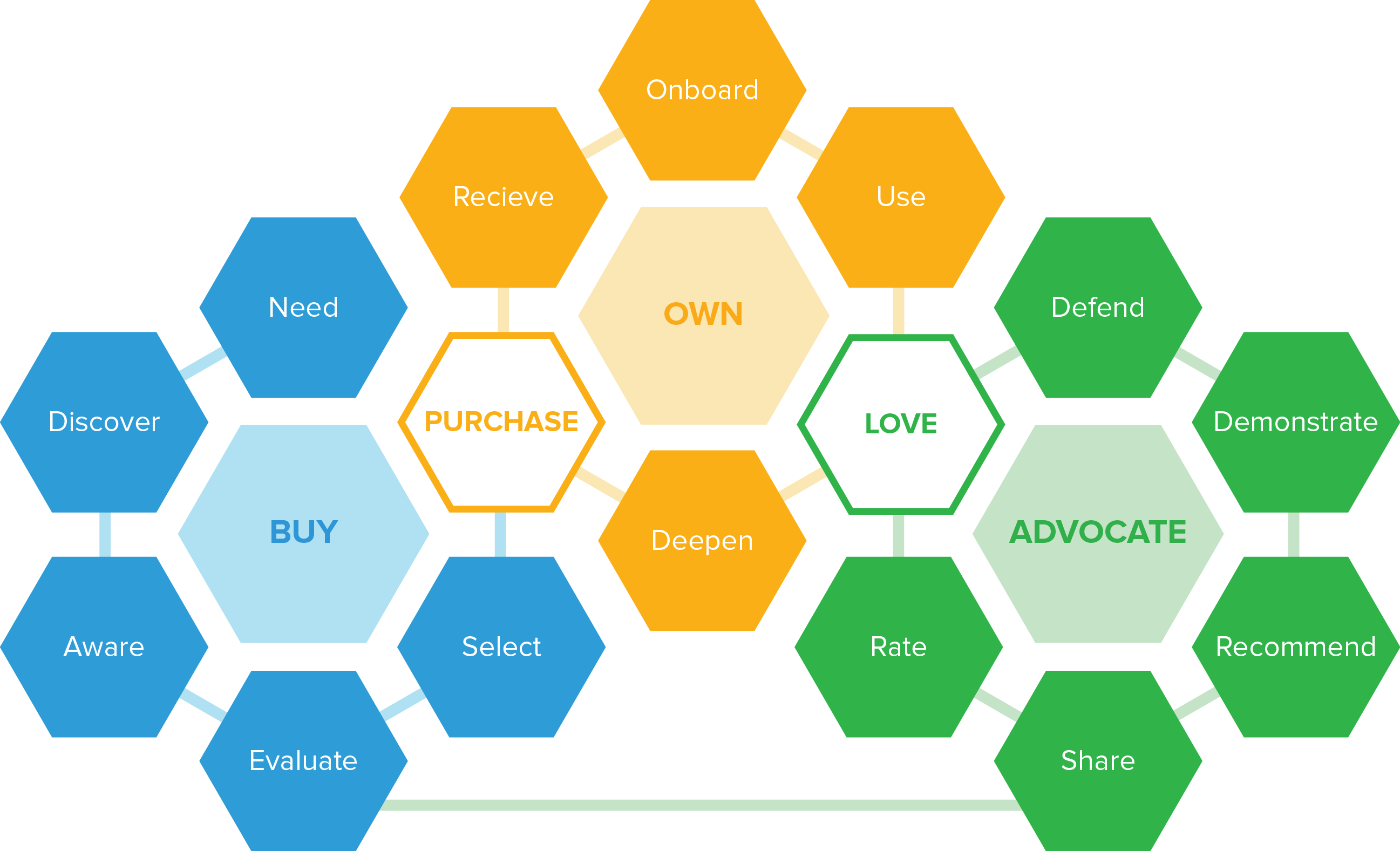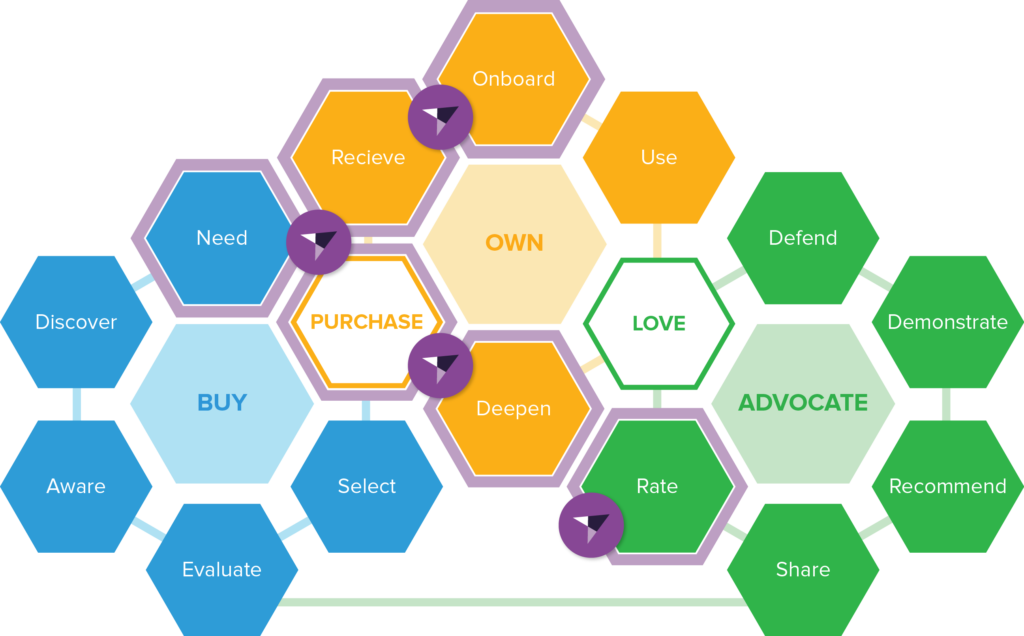The customer journey goes beyond purchase. It starts before we buy – with need and discovery stages, moving through purchase to delivery, onboarding, use and eventually (hopefully) advocacy. My friend, Augie Ray at Gartner, developed a great visual to describe this process – this customer journey which loops back to the start when we achieve repeat purchases from a loyal customer.

However, this wasn’t always how companies thought about the world or how their customers engaged. Many focused on initial acquisition and then let the chips fall where they may in terms of service, support, longer term engagement and brand loyalty. As brands have learned this, they’ve started to embrace the concept of LTV. In fact, about three years ago I wrote a piece on the emergence of LTV and CX were being paired like PB & J in the most sophisticated marketing organizations.
This same ethos is starting to infuse into supply chain teams. Because consumers have exponentially more choices for the brands they can buy from, improving loyalty and generating repeat purchases has become critical on the path to long term growth — and higher lifetime value.
So… what does LTV have to do with supply chain, much less shipping and logistics?
Supply chain and logistics can make or break that critical delivery part of the customer journey, and some of our most sophisticated clients are taking these trends to heart. They use CRM data to identify their highest value customers, proactively handling issues in the product fulfillment process.
One high-end furniture brand uses customer loyalty program CRM data in concert with Convey’s exception data to identify distressed orders bound for VIP customers. This allows them to take action on those orders before customers even know there is a problem — whether that means something as drastic as cancelling a damaged item and re-shipping an order from a different distribution center to meet a promise date. They can also actions as simple as expediting an existing order and sending the customer an update.
Uncommon Goods used exception data from Convey at a critical shopping time — Father’s Day — to do similar proactive handling, ensuring that they kept their word when it came to delivering gifts on time. There are many key points in the customer journey where shipping, logistics, customer support and digital teams all come together to impact customer outcomes, including: needing, purchasing, receiving, deepening relationship, and eventually rating.

By collaborating across teams, mature brands use shared data, visibility and collaboration tools to:
- Reassure and inform customers between purchase and receipt with branded tracking pages, customized alerts and communications
- Support customers as they onboard — and learn how to use — new products with visibility that empowers customer care staff to return, disposition or handle an errant or damaged shipment
- Provide mechanisms for feedback and rating of the shipment and deepen the relationship by meeting promises that get customers to come back
The last touchpoint in the customer journey… enables memorable experiences that can earn customer trust.
The last touchpoint in the customer journey is critical to master, and enables memorable experiences that can earn customer trust and increase customer lifetime value. Even the most loyal customers will remember if they have a positive delivery experience — 52% of power shoppers say that delivery efficiency and ease of service are the defining factors of brand loyalty.
Make Final Mile Delivery a Key Part of Customer Experience Conversations
Everything that touches your brand has an impact on customer experience and the likelihood to re-purchase and/or advocate for your brand. Your teams sweat the details when it comes to the packaging, design and even unboxing experience (as many of us have learned from Apple’s success elevating a product with beautiful surroundings). Why wouldn’t you sweat the details of how and when that package arrives?
It’s no longer acceptable to leave customers hanging – they want to know where their stuff is.
Customers expect to get their deliveries fast and free – usually with updates along the way. It’s no longer acceptable to leave customers hanging – they want to know where their stuff is. And if you spent all that time on beautiful branded packaging, why would you leave the tracking, alerts and engagement up to anyone else?
Use CRM and Shipping Data to Identify and Proactively Resolve Shipping Issues for High Value Customers
Once you’ve solved the basics of the delivery experience, you can start to think about what you want the VIP delivery experience to look like. Whether you have a formal loyalty program or not, your organization likely has CRM data that can identify the top 10% of your customers who probably make up an outsized portion of your revenue (and love to talk about your brand).
Supply Chain leaders should collaborate with your Customer Support and Marketing teams to identify how your CRM data can inform decisions you’ll make about delivery options, exception handling and customer engagement around the final mile experience.
Elevate NPS and CSAT as Supply Chain KPIs
Many supply chain leaders are starting to track customer satisfaction metrics with the most sophisticated leaning so far in that some of their bonuses and incentives are tied to either transactional CSAT or longer term NPS scores. Culturally, embracing customer experience outcomes as a critical outcome that can be influenced by supply chain is a sign of increasing maturity.
Now is the time to take what we inherently know about these unsung stages of the customer journey and explicitly prioritize them in service of growing strong customer relationships, increasing customer lifetime value, and driving business growth. Whether your company is in a “React” stage, where it feels like you’re jumping from fire to fire, or you are in a well-oiled “Automated” stage, with a role like ‘Chief Delivery Officer’ driving change, increasing visibility and collaboration to improve final mile delivery experiences should be top of mind.
Learn how to deliver higher lifetime value by providing context around shipments, or check out our insights on consumer delivery expectations.
